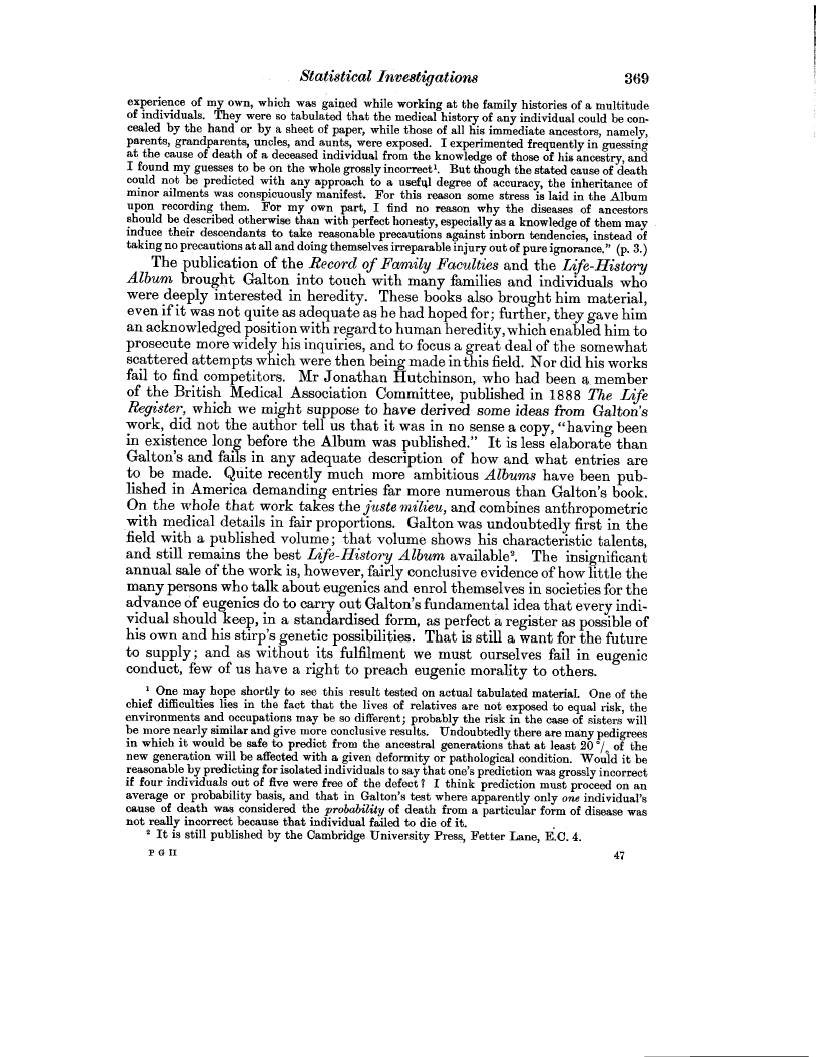Statistical Investigations 369
experience of my own, which was gained while working at the family histories of a multitude of individuals. They were so tabulated that the medical history of any individual could be concealed by the hand or by a sheet of paper, while those of all his immediate ancestors, namely, parents, grandparents, uncles, and aunts, were exposed. I experimented frequently in guessing at the cause of death of a deceased individual from the knowledge of those of his ancestry, and I found my guesses to be on the whole grossly incorrect'. But though the stated cause of death could not be predicted with any approach to a useful degree of accuracy, the inheritance of minor ailments was conspicuously manifest. For this reason some stress is laid in the Album upon recording them. For my own part, I find no reason why the diseases of ancestors should be described otherwise than with perfect honesty, especially as a knowledge of them may induce their descendants to take reasonable precautions against inborn tendencies, instead of
taking no precautions at all and doing themselves irreparable injury out of pure ignorance." (p. 3.)
The publication of the Record of Family Faculties and the Life-History Album brought Galton into touch with many families and individuals who were deeply interested in heredity. These books also brought him material, even if it was not quite as adequate as he had hoped for; further, they gave him an acknowledged position with regardto human heredity, which enabled him to prosecute more widely his inquiries, and to focus a great deal of the somewhat scattered attempts which were then being made in this field. Nor did his works fail to find competitors. Mr Jonathan Hutchinson, who had been a member of the British Medical Association Committee, published in 1888 The Life Register, which we might suppose to have derived some ideas from Galton's work, did not the author tell us that it was in no sense a copy, "having been in existence long before the Album was published." It is less elaborate than Galton's and fails in any adequate description of how and what entries are to be made. Quite recently much more ambitious Albums have been published in America demanding entries far more numerous than Galton's book. On the whole that work takes the juste milieu, and combines anthropometric with medical details in fair proportions. Galton was undoubtedly first in the field with a published volume; that volume shows his characteristic talents, and still remains the best Life-History Album available 2. The insignificant annual sale of the work is, however, fairly conclusive evidence of how little the many persons who talk about eugenics and enrol themselves in societies for the advance of eugenics do to carry out Galton's fundamental idea that every individual should keep, in a standardised form, as perfect a register as possible of his own and his stirp's genetic possibilities. That is still a want for the future to supply; and as without its fulfilment we must ourselves fail in eugenic conduct, few of us have a right to preach eugenic morality to others.
' One may hope shortly to see this result tested on actual tabulated material. One of the chief difficulties lies in the fact that the lives of relatives are not exposed to equal risk, the environments and occupations may be so different; probably the risk in the case of sisters will
be more nearly similar and give more conclusive results. Undoubtedly there are many pedigrees in which it would be safe to predict from the ancestral generations that at least 20'/. of the new generation will be affected with a given deformity or pathological condition. Would it be reasonable by predicting for isolated individuals to say that one's prediction was grossly incorrect if four individuals out of five were free of the defect? I think prediction must proceed on an average or probability basis, and that in Galton's test where apparently only one individual's cause of death was considered the probability of death from a particular form of disease was not really incorrect because that individual failed to die of it.
2 It is still published by the Cambridge University Press, Fetter Lane, E.C. 4.
PGII 47

